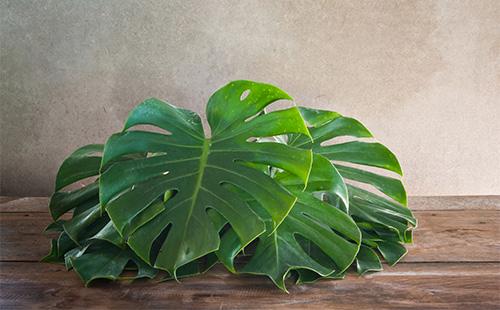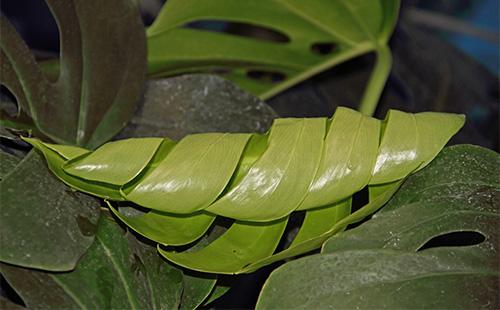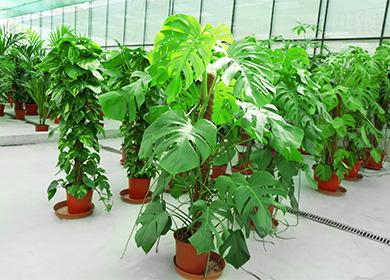The content of the article
Monstera is a bright representative of a large family of aroid. The natural habitat is the damp, warm forests of North and South America. Widely used for landscaping apartments and offices.
Botanical Description
The leaves are large, up to half a meter in diameter, leathery, dark. At a young age they are whole, heart-shaped. Over time, the shape of the leaves changes, becomes more interesting - deeply dissected, with numerous holes of different sizes appear. Petioles are long, in well-developed adult plants reach a meter.
The stems are curly, strong. Long cordy aerial roots descend from the main nodes. They tend to the surface of the earth, independently rooted near the main stem. Functions of aerial roots - creating support, obtaining additional moisture and nutrition from air, soil.
Despite the fact that the plant produces many aerial roots, they are not enough to hold the heavy stem of the monstera. Some do not plunge into the soil, but like suckers attached to the wall.
At home, monstera blooms rarely. Of small flowers, an ear-shaped inflorescence is formed, covered with a greenish veil. It looks like a flower spathiphyllum. If the inflorescence is not removed, the fruit ripens - an ear consisting of berries.
Interesting varieties
There are about 50 varieties of monstera in the genus. All of them differ in appearance, size, structure. As indoor crops, only five species are used.
- Delicacy. Young sheets without cuts, heart-shaped. As they grow older, they become deeply dissected. The leaves are large - about 60 cm in diameter. During flowering, a cob-shaped inflorescence up to 25 cm long is formed, wrapped in a light veil with a slight greenish tint. In an apartment, the length of the vine does not exceed three meters. With proper care, an adult plant can bloom annually. Hybrid variegate form artificially derived. It is characterized by improved decorative characteristics, but grows more slowly, more demanding to care.
- Adanson. The variety is characterized by thinner ovoid leaves with many small holes. The inflorescence is cob-shaped, up to 13 cm long. In cramped conditions, it does not bloom.
- Borziga. A kind of delicious monstera. The main differences are thinner stems and smaller leaves.
- Slanting. Leaves are elliptical or oblong lanceolate, without cuts. Attached to the stem with short stalks. The ear consists of several flowers, about 4 cm long.
- Punched (full of holes). Leaves expanded at the base, unequal. Numerous holes are distributed unevenly on the sheet plane. The inflorescence is medium in size, covered with a white veil.
Actions after the purchase
On how you will care for the monster after the purchase, its subsequent development depends. A small sprout in a pot will very quickly turn into a large vine. But for this he needs to create suitable conditions, taking into account four parameters.
- Transfer. It is better to transplant the monstera into another pot immediately after purchase. Long stay in the transport soil will adversely affect the development of the plant. The capacity is chosen taking into account the rapid growth of lianas, a thick layer of drainage is necessarily poured.
- Disease prevention. The initial stages of the disease and single pests may go unnoticed during inspection. To prevent insect infestations, monstera is treated with small doses of insecticide and fungicide in turn.
- Seat selection. Immediately choose a suitable place - warm, sufficiently lit, with the possibility of installing a support or pulling ropes. Usually a monster is placed in the most lit corner of the room. Rearranging a grown vine will not be easy.
- Humidity. For faster adaptation, monstera requires increased humidity. Additionally, you can spray the vine with water with the addition of a small amount of growth stimulant.
Caring for a monster: what to consider
Monstera is considered quite unpretentious, easy-care vine. The main difficulty lies in creating reliable supports for fast-growing shoots, maintaining high humidity. How to care for a monster, and create favorable conditions for growth for it?
- Lighting. For full growth, the monstera needs a lot of light, but she does not like the direct sun. They are placed in a room facing east, west or south. It is not recommended to keep it on the north side. Choose the lightest corner of the room. With a lack of light, the leaves become smaller, the aerial roots become thin and weak.
- Temperature. There are no strict requirements for observing the temperature regime. But at high rates, the monstera is growing faster. Favorable temperature in spring and autumn is about 20–25 ˚С. It reacts normally to heat. In winter, it is recommended to lower the temperature of the content to 16–18 ° C. Temporary cooling is needed for subsequent flowering. Drafts are avoided at any time of the year.
- Watering. Pour monstera properly with warm, pre-boiled and settled water. The frequency of watering is determined by the conditions of detention, the volume of soil and the size of the vine. Large leaves actively evaporate moisture, therefore, maintain a stable soil moisture. In late spring, summer and early autumn, watering is plentiful, frequent - immediately after drying of the soil surface.
- Humidity. Monstera needs daily spraying with warm boiled water. They additionally increase humidity using special devices, arranging cans of water in close proximity to the pot. As the dust settles on the leaves, they are gently wiped with a damp cloth.
- Top dressing. Young plants need not be fed. Adult specimens need regular feeding. Use balanced fertilizer for deciduous crops. To stimulate flowering, you can fertilize the monstera complex with phosphorus content.
- The soil. The composition of the soil varies depending on the age of the vines. Young plants need neutral or slightly acidic soil. It consists of sand, peat, turf and humus. The optimum acidity is pH 5.5–6.0. As they grow, they include hardwood soil.
- Pruning. If the adult vine stops growing, cut off the crown of the head to stimulate branching. The liana does not need regular pruning.
- Transfer. Young specimens are transplanted annually, large ones in three to four years. Take into account the peculiarities of caring for a monster after transplantation - moderately moist soil, shading from the sun, daily spraying. Microdoses of a growth promoter are added to water.
- Polishing. Liana needs high humidity, but after spraying the leaves become dull. To give them shine, special polishing sprays are used.
Flowering conditions
In reviews, flower growers often complain that the liana does not bloom. At home, only a delicate monstera can bloom. To do this, create conditions as close as possible to the climate of the tropics.
- Bright lighting. Monstera should receive enough diffused sunlight at any time of the year. In winter, it is advisable to provide additional illumination.
- High humidity. It is necessary to spray the vines daily. And in hot weather - several times a day.
- Loose soil. Soil is taken to the best of nutritious, loose, easily passing water and air.
- Spacious pot. Monstera does not tolerate crowding. The pot is taken large, "for growth."
- Aerial roots. They are helped to take root in the same pot or immerse them in water bottles. You can’t cut the roots!
Subject to all these rules, the monstera will fully develop. But flowering can not be expected from a young plant - peduncles are formed only on adult or old specimens.

Breeding methods
Monstera is considered not just unpretentious, but a tenacious plant. It easily propagates vegetatively. Monstera can be propagated by five different methods.
- Apical cuttings. Cut off the top with several leaves, put in a jar of water. After the appearance of the roots, they are planted in a pot with a light substrate. After trimming the crown, lateral shoots are formed on the main stem.
- Stem cuttings. The most common method of reproduction. Used mainly to rejuvenate old specimens with bald stems. The stalk is cut into pieces. At least one kidney is left on each of them. Root stem cuttings in wet sand or a mixture of sand and peat. Before planting, the sections are slightly dried, treated with carbon powder. If there are aerial roots on the handle, they are laid along the perimeter of the pot, lightly sprinkled with soil. Three cuttings are planted in one pot at once. For quick rooting, they create greenhouse conditions - they cover the segments of the stem with banks or polyethylene.
- Lateral processes. By analogy with the rooting of the apical cuttings, lateral shoots can also be rooted. But not every monster has them.
- Leaves. The leaf is cut off at the very base, capturing a small piece of the stem. They put it in a jar of water, wait for the formation of a dense ball of roots, and only then plant it in the soil.
- Air layering. Choose a side shoot of a monstera with small aerial roots. At the root level, the shoot is wrapped with wet sphagnum, fixed with cling film. Moss is regularly moistened. After root formation, the shoot is carefully cut, planted in the soil.
Seed propagation is used very rarely. Seedlings grow slowly - in the first two years of life they form only three to five leaves.
Common florist errors
From improper care, decorative vines suffer. Leaves are fading or turning pale, growth is weakening, the stem is stretched and exposed. To understand what conditions of detention are violated, it is enough to study the table.
Table - Monster Care Mistakes and Their Consequences
| External manifestations | Possible reasons | Help the plant |
|---|---|---|
| Monstera leaves dry | - dry air; - drying of the soil; - the appearance of pests | - Inspect for pests; - more often sprayed and watered |
| Brown spots appear on the leaves. | - lack of potassium; - sunburn | - Transplanted liana with a complete replacement of the soil; - make potash fertilizers |
| Young leaves become pale and small | - Poor lighting | - Move the pot closer to the window or organize additional lighting |
| Leaves massively yellow and wither | - Waterlogging of the soil; - root decay | - Monstera is transplanted, damaged roots are cut, their condition is assessed; - with severe decay cut off and root the top |
| Long no new leaves | - Lack of nutrition; - cramped pot; - irregular watering; - dim lighting | - Normalize the conditions of detention; - transplanted monstera; - make complex fertilizer |
| Leaves turn yellow, dry patches appear | - Drying earthen coma | - Often watered |
| Leaves acquire a brownish tint, look "paper" | - low humidity | - Monster is regularly sprayed, use special humidifiers |

Pests and diseases
Monstera rarely gets sick. Sometimes you have to deal with fungal diseases, root decay as a result of poor drainage or overflow. Treatment in both cases is carried out according to one scheme - rotten roots are cut off, treated with carbon powder and fungicide. Liana is transplanted into fresh, sterile soil. With severe damage to the roots, they cannot be reanimated. In this case, the top is trimmed and rooted. You have to deal with pests much more often. Their description and signs of damage can be seen in the table.
Table - Monster Pests
| Pest | Description | External manifestations | Methods of struggle |
|---|---|---|---|
| Shield | Insects up to 2 mm in size with a dense guard | - Small brown tubercles appear; - the plant is covered with sticky secretions; - the leaves are chirping | - Scabs are removed with tweezers or a brush; - wipe the affected areas with alcohol; - sprayed with the drug "Actellic" |
| Spider mite | Tiny red spider-like insect | - Small yellow specks appear on the leaves; - in a neglected state, the liana is covered with cobwebs | - Sprayed with drugs "Antikleshch", "Vermitek"; - they put the monstera in a bathroom filled with warm steam; - increase humidity |
| Thrips | Small black oblong insects | - On the outside of the sheet, silver stains form; - small black dots (insect excrement) are found on the inside | - Repeatedly sprayed with the drug “Fitoverm”, “Decis” at five-day intervals |
| Mealybug | Small shaggy bugs of white color | - A whitish coating forms; - lumps appearing resembling cotton wool (clusters of insects) | - Insects are removed with an alcohol wipe; - the vine is sprayed with Aktara |
Growing a monster's home flower is a great solution for beginners and busy people. This is a fast-growing, beautiful and unpretentious plant. Monstera will revive any interior without causing much trouble to the owner.

